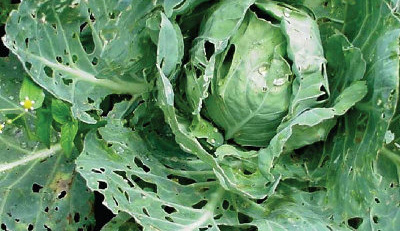Integrated Pest Management strategies
The following Good Agricultural Practices should be adopted for the management of various pests of Ridge gourd:
Destruction of debris, crop residues, weeds & other alternate hosts Deep summer ploughing
Frequent raking of soil beneath the crop to expose and kill the eggs, grubs & pupa.
Hand collection and destruction of infested leaves and fruits.
Adoption of proper crop rotation and avoid growing of cucurbit crops in sequence.
Use of resistant and tolerant varieties recommended by the State Agricultural Universities of the region.
Early maturing varieties are less affected by fruit flies than later ones.
Slight raking of soil during fruiting time and after the harvest to expose pupae from the soil.
Use cue-lure traps to attract B. cucurbitae males.
Use poison bait against fruit fly-mix 500 gm jaggery, 20 ml malathion and keeping plastic containers (100ml/container) @ 5 nos/Acre for monitoring and 20/acre for mass killing of fruit fly.
Use fish meal trap @ 10-15 nos/acre for fruit fly.
Use 10 banana pulp traps/acre against fruit fly-mix 20gm banana pulp, 3 drops of palm oil and 10 granules of carbofuran and keep in plastic container.
Cover fruits with polythene/ paper bags to minimize fruit fly infestation.
Conserve predators such as Pennsylvania leather wing beetle (Chauliognathus pensylvanicus); larvae of which feed on pumpkin beetle larva.
Conserve parasitoids such as Celatoria setosa (grub)
Use well decomposed FYM @ 8-10 tones per acre or wormi-compost @ 5 tons per acre treated with Trichoderma sp. and Pseudomonas sp. @ 2 kg per acre as seed / nursery treatment and soil application for controlling soil borne disease such as root rot, wilting.
Apply neem cake @ 100 kg per acre for reducing nematode population.
1. Fruit fly (Batrocera cucurbitae): Egg laying puncture marks on fruit surface, oozing of fruits juice. Softening & water soaked lesion on fruits. At later stage fruit get rotten. A female lays eggs under the skin of host fruit. After hatching legless & head less rice shaped maggot feeds on fruit pulp. Full grown larvae come out from fruit for pupation in the soil. Adult with hyaline wings with costal band broad and prominent, anal stripes well developed and hind cross veins thickly margined with brown and grey spots at the apex & face with two black spot.
2. Thrips (Thrips palmi): Thrips palmi is polyphagous but mostly found on Cucurbitaceae and Solanaceae crops. Egg is colorless to pale white in color, and bean-shaped in form; turns yellow towards maturation; laid singly inside the plant tissues. The larvae resemble the adults in general body form though they lack wings and are smaller. They usually feed on older leaves. Full fed larvae descends to the soils of leaf litter where it pupates making an earthen chamber. Adult are pale yellow with numerous dark setae. A black line from the juncture of wings runs along the back of the body. Slender fringed wings are pale. Fringe is shorter on the anterior edge than posterior. Body length is 0.8 -1.0 mm. adults feed on young growth. Thrips antenna is seven segmented, Ocelli red pigmented.
3. Whiteflies (Bemisia tabacii): Eggs are yellowish white laid singly on the under surface of leaves. Nymphs are yellowish and brownish, sub elliptical and scale like. They are found in large numbers on underside of leaves. Pupae also resemble nymphs in shape and have brownish opercula. Whitefly is a well-known vector, which transmits leaf curl virus. It has piercing and sucking mouthpart and both nymphs and adults feed on lower surface of the leaves causing deformation of young leaves. Whiteflies also excrete honeydew, causing sooty mold.
4. Aphid (Aphis gossypii): This is a cosmopolitan pest and highly polyphagous. It prefers to feed on cotton, cucurbits, eggplant, and okra. The adult color is highly variable and it varies from light green to greenish brown. The adult color is highly variable and it varies from light green to greenish brown. Both wingless and winged forms occur. They possess a pair of black-colored cornicles on the dorsal side of the abdomen. Aphids mostly are found in groups. Both the nymphs and adults possess piercing and sucking mouthparts. They occur in large numbers on the tender shoots and lower leaf surfaces, and suck the plant sap. Slightly infested leaves exhibit yellowing. Severe aphid infestations cause young leaves to curl and become deformed.
5. Leaf miner (Lyriomyza trifolii): This polyphagous pest causes characteristic white twisting lines in ash gourd, Cucurmis sativus and Cucurmis melo. Severe leaf mining accelerates leaf drop and retards growth and yield of plants. Mated females puncture leaves and lays eggs in leaf tissues. After hatching, larvae start feeding in palisade mesophyll cells of leaves while moving inside. Mines start from margins of leaves and progress towards centre. Adult look pale yellow in colour. Yellow larvae can be seen at the end of mines. Larval duration is 4-6 days. When larva is ready to pupate, it cuts a semicircular slit on leaf surface and fall down on ground.
6. Red spider mites (Tetranychus sp.): This pest is serious on cucurbits during warmer climate. Colonies of mites with in silk web can be observed on ventral leaf surface when incidence is high. Adult mites have eight legs and an oval body with two red eyespots near the head end. Eggs are spherical and translucent, like tiny droplets, becoming cream colored before hatching. Larvae, nymphs and adults of mites lacerate leaves from under surface and suck sap resulting in roduction of white patches between veins. Infested leaves turn yellow and fall



Leave a Reply